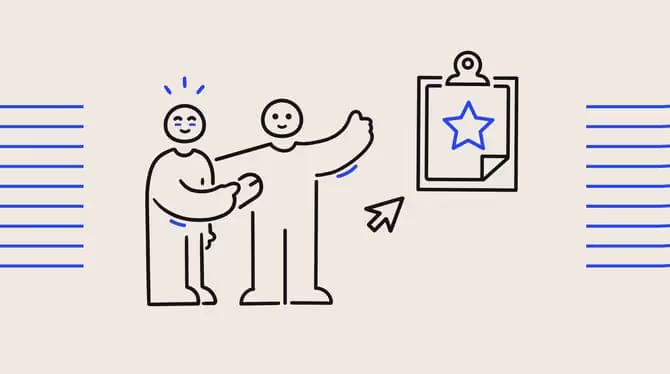The unconventional guide to performance reviews

Discover Workleap Officevibe's benchmark report on 12 key employee engagement metrics

Performance reviews, when done properly, can be an amazing tool to align your employees around their goals.
Unfortunately, proper employee performance reviews often fall by the wayside. Managers get busy and they sometimes fall into the trap of either only focusing on recent events (this is called the recency bias), or they'll use ranking systems that are unfair to most employees (especially top performers).
In the past, traditional performance reviews have been seen as tedious. That's why so many companies have started to change their approaches. Deloitte, Accenture, Gap, GE, Microsoft, and many others have scrapped the annual employee performance review in favor of “frequent check-ins.”
In theory, getting rid of something because it isn't working isn't a bad thing. And we are all for more frequent opportunities for performance feedback.
Performance reviews should be one small part of your entire performance management process.
That said, there is a real value in having a structured performance evaluation process, where performance reviews have a proper place. The truth is, when executed well, a performance review can be really powerful — for both managers and employees.
What exactly is a performance review?
A performance review comes in all types of types of forms and cadences. Some are more formal than others. Some occur annually while others more frequently. But at the core, a performance review is a structured process conducted by managers to evaluate employee performance.
{highlight}A well-structured performance review requires the following:
- A one-on-one formula between an employee and their direct manager
- A measurement of employee performance over a specific period of time
- Points discussed by both parties are documented
- An action plan and next steps that are put in place at the end
- A regularly occurring schedule (ex: every quarter or every year){highlight}
Most importantly, employee performance reviews serve as a benchmark to assess job-related expectations, accomplishments, strengths, areas for improvement, and future goals — and an opportunity for feedback and course correction if need be.
Goals of an employee performance review
Employee performance reviews have clear objectives that benefit both employees and the organization. These reviews offer valuable feedback to employees, acknowledging their accomplishments and pinpointing areas for improvement. They also serve as a means to align personal goals with the company's larger objectives.
{highlight}In the realm of managerial decisions, performance reviews play a pivotal role in:
- Determining promotions, salary adjustments, and bonuses.
- Identifying high-potential employees.
- Seeing who might benefit from further training or support.{highlight}
However, it's important to note that a performance review isn't a one-sided feedback mechanism; it's a two-way street. These reviews foster mutual understanding by providing employees and managers with an accurate picture of ongoing progress. This process enhances communication and transparency, creating a platform for open discussions about performance, career advancement, and skill enhancement. Ultimately, the performance review process promotes accountability, ensuring both managers and employees are actively engaged in driving success.
So, performance reviews? They're not just a chat. They're like a teamwork booster, a career roadmap, and a high-five station — all rolled into one.
Benefits of employee performance reviews
Unlike ad hoc 'check-ins,' a performance review provides a formal structure for documenting an employee's performance history. This is valuable for supporting employees — including future referencing, succession planning, and addressing performance-related issues. However, it is also crucial for supporting managers in delivering effective performance management.
{highlight}When well-executed, the performance review process contributes to:
- Increasing employee engagement, motivation, and retention.
- Fostering a culture of continuous learning, development, and accountability.
- Improving overall organizational performance.{highlight}
Performance reviews are one of many tools available for managers to engage, motivate, and retain their employees. They have different tools for different situations, and they need to know when to use which tool.
Types of employee performance reviews
Kudos to the companies that switched from annual performance reviews to more frequent check-ins, but it's not necessary to get rid of them.
At a high level, here is how you should use each feedback tool you have. We'll go into more detail throughout the post.
- Monthly one-on-ones: Remember,one-on-ones aren't supposed to focus solely on performance. Use this time to see how employees are feeling. See these one-on-one template agendas for ideas.
- Quarterly team performance: Team goals and individual goals both contribute to an organization's larger objectives. However, collective team goals can provide broader alignment and foster collaboration. Set quarterly goals and monitor performance as a team. Check out these performance goals for employees here.
- Annual performance review: This is where you can use data from the whole year to talk about an employee's performance and help them set and reach career goals.
- Real-time feedback: An important thing to keep in mind is in addition to these feedback tools, you should give employees feedback in as near real-time as possible.
Focusing on continuous performance management with a centralized process
Modern Marketing & Commerce (MMC), formerly known as Modern Marketing Concepts, is a New York-based company that helps businesses grow through digital strategies and optimization.
Why they needed help
Before Officevibe, Kathryn Kellam, the former VP of Sales and Marketing at MMC, had a tough time keeping track of her chats with team members. She used papers and computer notes to document her employee performance evaluations, which often got lost or mixed up. Her performance management system needed a bit of help, but then Officevibe came along to offer a hand.
Having better conversations
Officevibe is more than just surveys. It also has a special tool for one-on-one talks, simplifying the infamous employee performance review. Kathryn liked the trial so much that she started using Officevibe integrally. It helped her turn regular chats into super useful talks to inform performance evaluations. She shared survey results with her team and used them to plan more efficiently for the future.
Making chats more efficient
Kathryn and her team used Officevibe to make lists of things they wanted to discuss. It was like having a plan for their formal (and informal) performance review moments. They even added things during the week that they didn't want to forget. This was especially helpful for their hybrid workforce.
Happy team, great score
With certain processes streamlined, MMC enjoyed a stellar engagement score of 9.4. Kathryn thinks the 1-on-1 tool made a big difference in her review process: "Using this tool for chats and keeping notes really helped us get this great score."
Their secret to great chats
Kathryn’s secret to genuine employee performance chats was simple: be open and talk about everything. She asked her team about their lives outside the office and what they wanted to do at work. They also discussed what they need help with. Using Officevibe, they made lists of follow-up items which helped fuel collaboration and alignment.
In the end
Thanks to Officevibe's 1-on-1 tool, Kathryn and her team were able to have better conversations and work more collaboratively with their performance review process.
Performance review tips
Here are a few helpful employee performance review tips for you to keep in mind as you're structuring your review:
1. Set clear goals from the beginning
One of the biggest challenges with employee performance reviews is that they're not usually based on data, which leaves space for forgetting and biases. If you set clear goals from the beginning, you'll be able to accurately and fairly measure performance. If you and an employee agree on goals, they're less likely to challenge any negative feedback because it was made clear what you both would be measuring.
2. Remove any fear
Annual performance reviews can be incredibly nerve-racking for employees so it's important that you calm their fears.
Start the meeting on a positive note, let them know that it's their meeting and that you're there to help them grow in their career. If you can set the tone early on in the meeting, you'll be much better off.
3. Use multiple data points
Use the goals you set, milestones they've achieved, reviews from other coworkers, and as many different data points as you possibly can to get a more accurate picture of employee performance.
The more sources of data you use, the less chance you have of bias getting in the way of the review.
4. Create an action plan
Together, with the employee, create an action plan that you both can agree on for what to improve for the following year. A good tip to keep in mind is to find out what the employee's career goals and plans are to make sure you help them get there. The annual performance review is the perfect time to have those career growth discussions.
Important: Make sure you provide any support necessary for them to achieve the goals in the action plan.
5. Take notes and follow up
Take notes of everything you're discussing during the performance review meeting, and at the end of the meeting, make sure to follow up with the employee by email to ensure everyone is on the same page.
Steps for a great performance review
Unlock the potential of your performance management process with a strategic approach to performance reviews. Let's delve into each step of the process:
- Preparation phase: Taking these steps ensures you're well-equipped to evaluate performance effectively. Gather data, revisit goals, and establish clear expectations. This groundwork sets the stage for a fruitful review.
- Gather relevant performance data and documentation: Before the performance review, collect essential data. For example, you can retrieve sales records that showcase revenue and deals closed, or explore customer feedback to understand interactions and compile project reports highlighting their contributions.
- Review the employee's job description, goals, and objectives: Familiarize yourself with their job description to refresh your memory on their official roles. Align their goals with company strategies. Consider any changes since the last review, ensuring a clear overview.
- Identify specific performance criteria and expectations: Define what counts. Outline performance factors such as hitting sales targets or teamwork. Quantify objectives like a 10% sales increase or maintaining high customer satisfaction.
- Scheduling and communication: Communication is key in a performance review. Schedule thoughtfully, ensuring the employee is comfortable and engaged. Transparency about the process fosters an open and productive dialogue.
- Schedule a meeting with the employee in advance: Plan ahead. Choose a suitable date and time, considering their preferences. Give them ample notice to prepare, ensuring a productive session.
- Clearly communicate the purpose and format of the review: Set the stage. Explain what the review aims to achieve and how it will unfold. Emphasize that it's a platform for open exchange and valuable feedback.
- Encourage the employee to self-assess their performance: Tap into their insights. Provide a self-assessment form, asking them to reflect on achievements and challenges. Their input shapes the discussion throughout the performance review.
- Opening the review: Kicking off on a positive note creates a receptive atmosphere. Outlining the review's structure and encouraging input helps build a collaborative and constructive exchange during the performance review.
- Begin the review by establishing a positive and constructive tone: Set the mood. Start on a positive note, acknowledging their contributions and dedication. Show appreciation for their efforts and that you have noticed their growth.
- Discuss the agenda and the structure of the review: Navigate the roadmap. Outline the topics you'll cover and the process's flow. Managing expectations about timing fosters a focused discussion.
- Encourage the employees to share their thoughts and concerns: Give them the floor. Create an environment where they feel comfortable sharing. Their perspective is valuable; listen actively and empathetically.
- Assessing Performance: By evaluating employee performance against defined criteria and showcasing specific achievements, you create a comprehensive and accurate view of their contributions.
- Evaluate the employee's performance against predetermined criteria: Get analytical. Measure against established criteria and objectives. Dive into performance data like sales or feedback, embracing both numbers and narrative.
- Provide specific examples of achievements and areas for improvement: Paint a vivid picture. Highlight instances where they excelled and bring up tangible examples. Tackle growth areas constructively, focusing on behaviors and skills.
- Seek input from relevant stakeholders, such as colleagues or clients: Broaden perspectives. Consult those who interact closely with the employee. Collect feedback from different angles to form a comprehensive assessment.
- Feedback and discussion: Balanced feedback and active dialogue promote growth. Acknowledging strengths and inviting their perspective lay the foundation for constructive improvement.
- Offer balanced and constructive feedback on strengths and weaknesses: Strike a balance. Begin with a nod to their strengths and accomplishments. Use real examples to showcase their positive impact. For growth areas, focus on actions and behaviors, steering clear of personal traits.
- Encourage employees to share their own perspectives: Open the floor. Create a safe space for them to express their thoughts and concerns. Listen keenly and acknowledge their viewpoints. Their insights are invaluable and help shape the conversation.
- Engage in a two-way dialogue and active listening: It's a conversation, not a monologue. Foster dialogue by posing open-ended questions. Seek clarity when needed, and encourage them to delve into their experiences. Keep the discussion balanced and inclusive.
- Goal setting: Crafting SMART goals together aligns individual aspirations with organizational objectives. This collaboration sparks motivation and guides their path forward.
- Collaboratively set new goals and performance expectations: Join forces. Dive into their aspirations for the upcoming period. Encourage them to share their own goals and dreams for professional growth. Harmonize individual aims with overarching company objectives.
- Ensure the goals are SMART (specific, measurable, achievable, relevant, time-bound): Get SMART. Nail down specifics, leaving no room for ambiguity. Make sure targets are measurable and realistic. Align goals with their roles, keeping an eye on both capability and available resources.
- Discuss development opportunities and career aspirations: Chart the path. Identify areas for skill enhancement. Chat about training, workshops, and mentorship. Uncover their career dreams and explore avenues for growth within the organization.
- Development and support: Identifying growth areas and offering guidance empowers professional development. Discussing training options and providing mentorship fuels continuous growth.
- Identify areas where the employee can enhance their skills or knowledge: Pinpoint growth spots. Discuss strengths and areas needing polish. Map out skills or competencies beneficial for performance and career advancement.
- Discuss available training programs or resources: Share the toolbox. Talk about training options, workshops, and courses. Detail internal resources like online learning platforms or mentorship schemes. Help them harness these resources effectively.
- Offer support and guidance for the employee's professional growth: Guide their journey. Extend mentorship or coaching. Steer them in crafting a personalized development plan. Delve into possibilities and new challenges to broaden their skill set.
- Performance ratings and summary: Providing an accurate rating, summarizing key points, and documenting outcomes offer clarity and direction for future endeavors.
- Provide a fair and accurate performance rating, if applicable: Measure up. Gauge their overall performance based on set criteria and goals. Employ a rating system in line with your organization's evaluation framework. Back the rating with concrete feedback highlighting strengths and areas to refine.
- Summarize key discussion points and action items: Synthesize the dialogue. Capture the main discussion points. Highlight achievements, growth areas, and upcoming goals. Reinforce agreed-upon action items, emphasizing the next moves.
- Follow-up and documentation: Continued support and ongoing check-ins ensure progress. Documenting the journey preserves insights and promotes accountability.
- Follow up on any commitments made during the review: Walk the talk. Ensure action items and development plans are put into motion. Lend support where needed. Arrange follow-up meetings to track progress and maintain a feedback loop.
- Document the performance review and store it securely: Seal the record. Craft a comprehensive document encompassing discussion points and feedback. Respect confidentiality and comply with data regulations. Store it safely for future reference.
- Schedule periodic check-ins to monitor progress and provide ongoing feedback: Stay connected. Arrange regular check-ins to gauge progress toward goals. Keep the feedback loop open and continuous. Use these sessions to address challenges and fine-tune their performance journey.
Each phase outlined above plays a pivotal and interconnected role in skillfully navigating the performance review process. By diligently following these steps, you lay a solid foundation for not only assessing performance but also fostering a culture of growth and continuous improvement within your team.
Performance review phrases to use
One important thing to keep in mind when giving feedback during your review process is to focus on behaviors and not personality traits. Behaviors can be changed, whereas personality traits are harder to change.
With that said, here are a few examples of phrases you can use in your next performance review:
- Handles receiving constructive feedback well
- Is constantly looking for ways to improve their work
- Communicates with the team clearly and concisely
- Shows up on time to meetings
- Shares knowledge with coworkers
- Completes projects on time and meets deadlines
- Gives feedback and challenges their coworkers
- Helps the team stay calm under pressure
- Is a good listener and has an open mind
- Contributes ideas and suggestions regularly for how to improve the business
- Is able to balance several projects at once
- Gives recognition to their peers
Common issues with performance reviews
Performance reviews (or performance appraisals), while essential, can sometimes stumble upon familiar challenges. Let's demystify these issues and explore ways to navigate them effectively, which is generally part of effective performance management:
- Lack of preparation: Before conducting a performance review, it's crucial to gather ample performance data and relevant documentation. Moreover, familiarize yourself with the employee's goals, objectives, and job description to provide a comprehensive performance evaluation. Without proper preparation, your annual reviews may feel incomplete and inefficient.
- Biased or inconsistent evaluation: Stay vigilant against personal biases that might inadvertently affect your performance evaluation. Consistency is key; apply the same performance criteria across all employees to ensure fairness.
- Lack of specificity: When giving feedback during the review process, steer clear of vague statements. Instead, offer concrete examples to provide clarity. Explicitly communicate areas that need improvement to foster actionable progress.
- Neglecting two-way communication: Remember, an effective performance review is one that promotes open dialogue. Encourage the employee to share their perspective. Listen actively, valuing their input and concerns to facilitate a productive conversation.
- Focusing only on negatives: While addressing areas for improvement is vital, don't overshadow achievements within the employee performance review. Acknowledge strengths and accomplishments, and offer constructive feedback for well-rounded growth.
- Failure to set clear goals: Setting achievable and well-defined goals together is paramount. Unrealistic expectations can lead to frustration. Collaborate to establish targets that align with the employee's role and the organization's vision to be assessed again at the next employee performance review.
- Overlooking employee development: Use the appraisal as an opportunity to discuss training, development prospects, and career aspirations. Provide guidance and resources that empower the employee's professional journey.
- Lack of follow-up and accountability: Don't let the momentum fade after the appraisal. Follow up on commitments and document progress to ensure accountability. This practice strengthens the impact of the appraisal process.
- Delayed or infrequent reviews: Consistency is key. Conduct performance reviews on schedule to provide timely feedback and course corrections. Avoiding irregularity ensures performance stays on track.
- Failure to document performance issues: Record performance-related concerns meticulously. Document discussions and agreements, creating a reliable reference point for future evaluations and developmental planning.
By steering clear of these common pitfalls, you can enhance the effectiveness of your employee performance review process and foster a culture of growth, development, and shared success.
Make performance reviews more effective with Officevibe
When it comes to effective performance management, performance reviews remain an integral part of the process. The key lies in simplifying the system to make them less heavy on managers and employees, and in nurturing a culture of trust within your organization. And for that, there are tools like Officevibe's upcoming performance management features.
There are many ways to modernize traditional performance reviews into an employee performance review process that is met with much enthusiasm! Incorporate peer reviews and link performance to core values to add a robust layer to your review process, elevating its impact and driving the point of collaboration home. Shifting the focus from personality traits to actionable behaviors is another game-changer. This shift ensures that reviews provide constructive and actionable feedback, enhancing employee growth and development.
Remember, the performance management doesn't end with the review. It's an ongoing collaboration, a commitment to continual improvement. Let your employees know that your shared goal is their development, and the review is merely a stepping stone in this collective journey.
The art of note-taking throughout the year is a gem of wisdom. By using technology to your advantage, you create a valuable reservoir of insights, minimizing the influence of biases and enriching the evaluation with substantial data. Embrace these insights from Officevibe, and watch your performance review process evolve into a dynamic force that propels your team and organization toward excellence. You'll have amazing reviews and catapult your performance management abilities!
Give HR and managers the clarity, confidence, and connection to lead better every day.


%20(1).avif)


.avif)
.avif)








